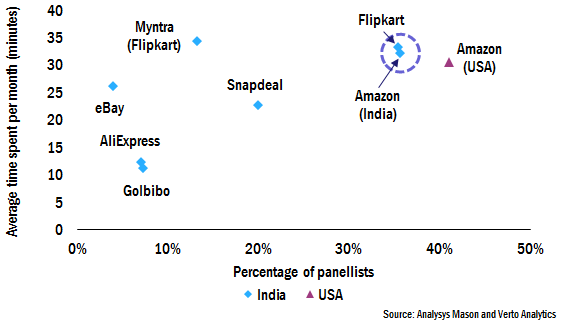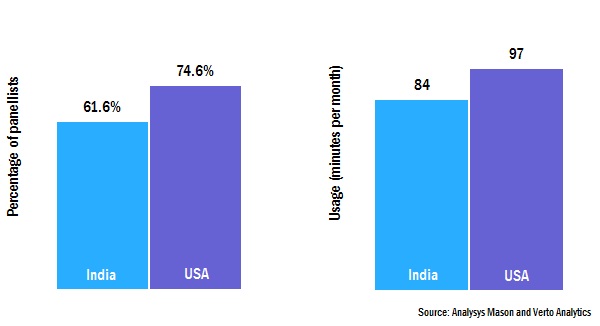Amazon and Flipkart lead the race to dominate India’s ecommerce market

The Indian ecommerce market is receiving significant attention. Flipkart has raised USD1.4 billion in new funding, and Snapdeal's investors are reportedly looking to merge it with a competitor. Analysys Mason's study of smartphone users in India provides some insight into the ecommerce market.1 The key findings are as follows.
- Amazon and Flipkart have a substantial lead over the other players. As is the case in other countries such as Japan, the UK and the USA, ecommerce is a 'winner takes most' market. Amazon and Flipkart's lead highlights the challenge facing the other e-commerce players in India.
- Amazon and Flipkart are almost equally well-placed. The adoption and usage figures of Amazon and Flipkart are almost identical; if Amazon has the lead, as it claims, it is a very slender one.
- Consumer behaviour data shows that India's ecommerce market is relatively mature. Our data does not capture spend (the real measure of success), but we can see that in terms of penetration and engagement Indian ecommerce players are only slightly behind the figures for the USA.
Ecommerce market leaders Amazon and Flipkart had nearly identical levels of penetration and engagement in India in 2016
Our research illustrates how close Amazon and Flipkart are in the race for dominance of the Indian ecommerce market. Amazon launched in India in 2013 and is the market leader by revenue, while local player Flipkart comes a close second. In our study, engagement with the apps from both companies was at similar levels; 36% of our panellists had Amazon India’s app and 35% had Flipkart’s. Panellists in India spent an average of over 32 minutes per month using Amazon’s app, and 33 minutes using Flipkart’s. For comparison, Amazon’s app was used by 41% of panellists in the USA for 31 minutes per month. Snapdeal is the third-largest player in India, but the gap between it and frontrunners Amazon and Flipkart is substantial.
Figure 1: Average time spent and penetration of selected ecommerce apps, India and USA (n = 3205)

The Indian ecommerce market is maturing rapidly, and few players will be left after further consolidation
Our study shows that the Indian ecommerce market is relatively mature, even compared to that of the USA. Nearly two-thirds of panellists in India used ecommerce apps, spending an average of 1 hour and 24 minutes per month. In the USA, in contrast, three out of four panellists used ecommerce apps for 1 hour and 37 minutes per month on average (see Figures 2 and 3).
Figure 2: Ecommerce app penetration (n = 6476) and average usage time per panellist (n = 4482), by country

Our panel in India comprised 2675 smartphone users with regular access to the Internet over cellular or Wi-Fi networks. This activity reflects the behaviour of a predominantly affluent, urban demographic, despite the differences in Internet penetration between India (26%) and the USA (74.5%).2
Indian consumers are price-sensitive and actively engage in price comparison and 'bargain-hunting' behaviour.3 This combination of high levels of engagement and price-sensitivity explains the interest of global players in capturing – or at least retaining – a sizable share of the ecommerce market in India before Amazon does. The Seattle-based company is playing a long-term game of carving market share dominance while subjecting competitors to cost attrition, a strategy that has led it to succeed in other countries, where the results suggest that ecommerce is a 'winner-takes-most' market in which second-placed players struggle as they fail to scale.
Flipkart and Snapdeal are trying to grow market share with discounts and promotions, despite increasing customer acquisition costs. This strategy is unsustainable in the long term, and foreshadows the prospect of consolidation in the Indian ecommerce market. To counteract Amazon's ascendancy, Microsoft, eBay and Tencent announced a USD1.4 billion investment in Flipkart in April 2017, and SoftBank – the majority stakeholder in the third-largest player, Snapdeal – is reportedly in talks with other investors in the company pushing for an acquisition of Snapdeal by Flipkart.4
Mobile wallets that integrate with online retailers will be key to ecommerce growth in India
There is a significant overlap between users of ecommerce apps and mobile payments in India, suggesting the potential convergence of ecommerce and mobile wallet players. In our study, 61% of panellists who used ecommerce apps were also users of mobile payment and wallet services. PayTM had the highest levels of penetration for a payment app in all the countries analysed, with 38% of the Indian panel.5 Mobile wallets from telecoms operators, like Airtel Money and JioMoney also fared better in India than in the other countries surveyed.6
Mobile wallets that integrate closely with online retailers, and simplify not only payments but the entire ecommerce experience (for example through price comparison or loyalty features) may be key to the growth of ecommerce in India. This helps to explain why PayTM’s ecommerce arm announced a USD200 million investment from investors including Chinese ecommerce giant Alibaba Group in March 2017.
1 Our analysis is based on data provided by Verto Analytics, collected during July and August 2016 using a passive on-device monitoring app called ‘Smart Panel’, which runs in the background of the device. The app registers actions undertaken by the user and relevant activity on the device, including app download and usage, data traffic by each app/process, etc. For more information on the methodology and our full findings for ecommerce and mobile financial services in India, see our forthcoming reports.
2 Internet user penetration aggregated by the World Bank for 2015. Available at: http://data.worldbank.org/indicator/IT.NET.USER.P2.
3 Price comparison and rewards apps were popular among our Indian panellists. DesiDime and IndiaFreeStuff both achieved a high DAU:MAU ratio of 47%, illustrating the bargain-hunting behaviour of Indian panellists.
4 Myntra, a fashion marketplace, merged with Flipkart in May 2014 in response to competitive pressure from Amazon.
5 Our study was conducted in July and August 2016, before the Indian Government’s decision to demonetise high-value bank notes in November of that year. It is likely that the demonetisation contributed to an increase in the use of apps like PayTM in that country.
6 For a discussion of mobile financial services in India, see Analysys Mason’s forthcoming report Consumer smartphone analytics 2016: mobile financial services and banking in India.
Downloads
Article (PDF)Latest Publications
AI series: Microsoft's Aileen Hannah on how AI can offer SMBs an edge over larger companies
Podcast
Mobile customer satisfaction: consumer survey
Survey report
AI series: who will be the GenAI winners and losers in the TMT industry?
